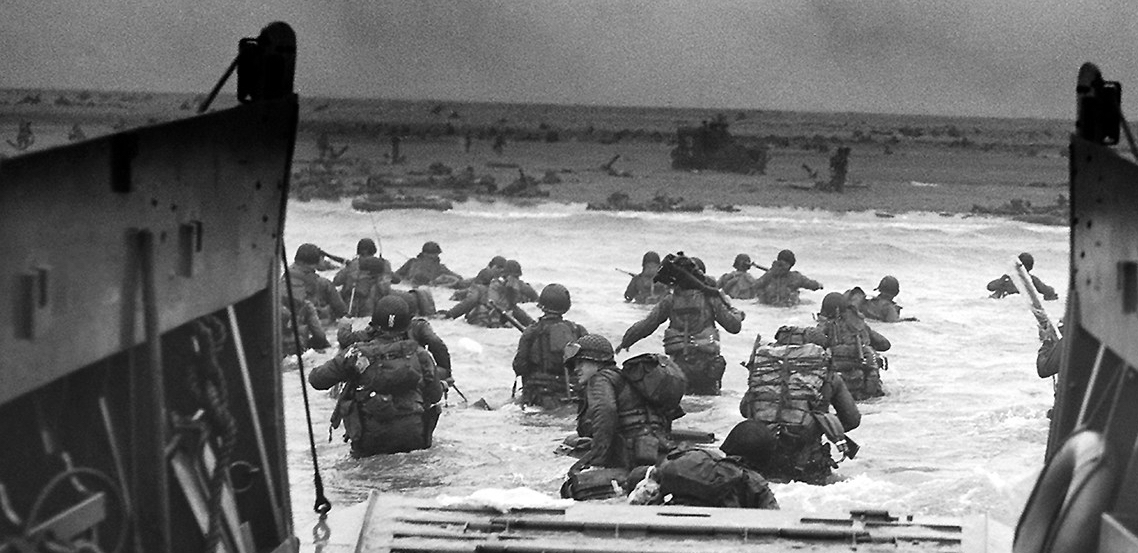Men against steel
Stunned by the sheer power of the Marine assault, Iwo Jima’s Japanese defenders soon found their second wind. They put into effect their fire plan, shelling the exposed beaches with a wide variety of artillery and mortar fire.

Heavily loaded Marines in one of the reserve waves hit the beach. These troops are double-timing off their landing boat. Ahead of them, other Marines are climbing on hands and knees. Later on D-Day, bulldozers will come ashore to cut tracks through the terrace. In some spots, it was more like a bluff and throughout the day, men and machines struggled to get past it.

Infantrymen from the 5th Marine Division dig foxholes near the looming bulk of Mount Suribachi. As more and more Japanese weapons fire into the Marines packed on the beach head, U.S. ships bring heavy supporting firepower to bear. On the flank of Suribachi, smoke rounds are being used to obscure the aim of enemy gunners. Iwo’s volcanic sand proved just as hard to dig as to walk through. For every shovelful that Marines threw out, it seemed that two fell back into their holes.

Navy Corpsmen gently place a severely wounded Marine on a litter. Throughout D-Day, casualties were evacuated out to the temporary hospital ships positioned 2,000 yards off the beach head. Many lives were saved due to the speed and efficiency of the medevac system.
Lifeless bodies of Marines rolled and tumbled in the surf; washing up on the beach like so many pieces of driftwood. Now colored by the blood of so many dead and dying, Red beach was true to its name…. Dodging enemy fire, I dropped to the ground alongside another Marine. His eyes were closed, as if he were sleeping. I could not distinguish the injury that took his young life; only that he was gone.
Indestructible by Medal of Honor recipient Jacklyn Lucas


A split-second in time as Marines charge off their landing boat.

On Red 2, a propeller from a crashed Navy aircraft has come to rest among the dead and dying.

Under a deluge of enemy artillery and mortar fire, Marines hug the deck. Pinned on the terrace, these troops must get off the beach to clear the way for follow-on waves. Although the landing plan is now a nothing but a memory, more and more landing craft and amtracs are still coming ashore.

A Navy Corpsman crawls to treat a wounded Marine after checking his fallen buddy. The difference between life and death existed in fractions of an inch on the beach that day.

Right offshore of the beach head, USS LCS(L) (3)-56 directs 3″ and 40mm fire to suppress Japanese heavy weapon emplacements on the slopes of Mount Suribachi. Throughout D-Day, these brave little ships remain on station, firing thousands of rounds at the enemy.

Smoke from the Japanese barrage drifts on the wind and Marines are already beginning to dig into the sand. For every entrenching tool they shovel out, more sand will cascade down into their holes.
Nor was the bloodshed limited to the thin crescent of beach head where the assault teams were pressing forward. A Higgins boat motored through the surf sometime after the amtracs had deposited the assault units, ferrying perhaps forty Marines. An American flag was attached to one of the gunwales – it was as if the passengers and crew were offering the enemy gunners a chance to zero in on them. Just as the bow door of the craft plunged into the surf, an artillery round struck directly in the boat, killing all hands.
The Lions of Iwo Jima by Fred Haynes and James A. Warren


As enemy rounds explode around them, Marines crawl and claw their way forward off the beach. On the far left flank, elements of B 1/28 reached Iwo’s western shore across the island’s narrowest point at 1035, losing many Marines and bypassing enemy strongpoints. In the 4th Marine Division sector on the right, assault troops pushed forward toward the O-1 line under an absolute rain of Japanese defensive fires. Elements of Landing Team 1/23 reached the edge of Motoyama #1 at 1405.

A Japanese artillery round scores a direct hit on a vulnerable target in the 5th Marine Division sector. In the foreground, a bulldozer and a medium tank are bogged down in the sand. Since the dozers struggled to cut through the terrace, follow-on vehicles were blocked from advancing off the beaches. Soon, the entire area was clogged with abandoned, junked or destroyed vehicles of all types.
Japanese artillery greeted the tanks as they crept along; one bogged down and was blanketed by mortar fire. Another pulled up about fifteen yards in front of us and stopped. Immediately, shells were falling all around us, the explosion caving in our foxholes. We were all white with fear. Sparkowski said nervously, “Let’s move!” But how could you move unless you wanted to be killed by the next sequence of shells they were throwing at you?
This Here is G Company by John E. Lane


This is a great picture collection of the landing on Iwo.
I have always felt this was the defining battle of the marine corps. I know many other battles were horrific but to me this was the battle. These are great pictures and comments on what was taking place.
Thank you